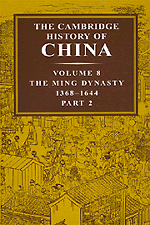Book contents
- Frontmatter
- Introduction
- 1 Ming government
- 2 The Ming fiscal administration
- 3 Ming law
- 4 The Ming and Inner Asia
- 5 Sino-Korean tributary relations under the Ming
- 6 Ming foreign relations: Southeast Asia
- 7 Relations with maritime Europeans, 1514–1662
- 8 Ming China and the emerging world economy, c. 1470–1650
- 9 The socio-economic development of rural China during the Ming
- 10 Communications and commerce
- 11 Confucian learning in late Ming thought
- 12 Learning from Heaven: the introduction of Christianity and other Western ideas into late Ming China
- 13 Official religion in the Ming
- 14 Ming Buddhism
- 15 Taoism in Ming culture
- Bibliographic notes
- Bibliography
- Glossary-Index
- References
5 - Sino-Korean tributary relations under the Ming
Published online by Cambridge University Press: 28 March 2008
- Frontmatter
- Introduction
- 1 Ming government
- 2 The Ming fiscal administration
- 3 Ming law
- 4 The Ming and Inner Asia
- 5 Sino-Korean tributary relations under the Ming
- 6 Ming foreign relations: Southeast Asia
- 7 Relations with maritime Europeans, 1514–1662
- 8 Ming China and the emerging world economy, c. 1470–1650
- 9 The socio-economic development of rural China during the Ming
- 10 Communications and commerce
- 11 Confucian learning in late Ming thought
- 12 Learning from Heaven: the introduction of Christianity and other Western ideas into late Ming China
- 13 Official religion in the Ming
- 14 Ming Buddhism
- 15 Taoism in Ming culture
- Bibliographic notes
- Bibliography
- Glossary-Index
- References
Summary
THE PATTERN OF SINO-KOREAN TRIBUTARY RELATIONS
Korea is often referred to as a model Chinese tributary state. Indeed, it would be difficult to exaggerate the importance of Korea's tributary relations with China in the development of Korean political institutions and higher culture. Beginning in the seventh century, when the Korean kingdom of Silla entered into an alliance with the T'ang, the Koreans became skilled at adapting Chinese institutions to their own needs. Later, the kingdom of Koryŏ (Chinese: Kao-li, A.D. 918–1392) continued this pattern of adaptation, watching closely as the Liao, Chin, and Mongol states rose in succession, and evolving forms of tributary relations with each in turn. Korea came under more direct imperial control with the completion of the Mongol conquest in 1270. Thereafter, Koryŏ princes were reared in Peking and were married to Mongol princesses, and Mongol commanderies were established at P'yŏng-yang and Ssangsŏng. During the decades of Yüan overlordship, as the Koryŏ ruling lineage intermarried with the Yüan imperial family, certain other Korean houses became powerful by marrying daughters to high Yüan officials. Over time, Korean ties to the Yüan became so important that the Koryŏ regime was ill-prepared to cope with the fall of the Yüan in the mid-fourteenth century. In many respects, the fall of Koryŏ and the rise of the state of Chosŏn in 1392 was related to the transition from the Yüan to the Ming dynasty in China, and the evolving relationship between China and Korea during the Ming period is a good example of how the tributary system served each side, both as a political tool and security mechanism, and as a conduit for trade and cultural transmission.
- Type
- Chapter
- Information
- The Cambridge History of China , pp. 272 - 300Publisher: Cambridge University PressPrint publication year: 1998
References
Accessibility information
- 12
- Cited by

